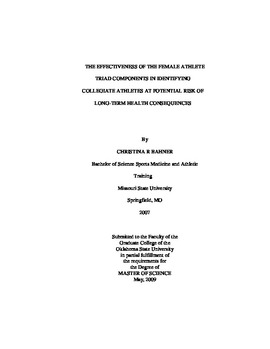| dc.contributor.advisor | Konz, Suzanne | |
| dc.contributor.author | Bahner, Christina R. | |
| dc.date.accessioned | 2014-04-16T03:11:23Z | |
| dc.date.available | 2014-04-16T03:11:23Z | |
| dc.date.issued | 2009-05-01 | |
| dc.identifier.uri | https://hdl.handle.net/11244/9728 | |
| dc.description.abstract | Research on the effects of excessive exercise on female athletes has increased to investigate three distinct, yet interrelated disorders: eating disorders, amenorrhea, and osteoporosis collectively termed the female athlete triad. However, previous literature has found few female athletes develop the female athlete triad according to the strict criteria of the components. When a female athlete does develop all three components, many of the effects are irreversible at that point. In addition, previous research suggests disordered eating, menstrual dysfunction, and subsequent impaired bone health is just as harmful to the female from a health and performance perspective. The purpose of this study was to examine the effectiveness of the current components of the female athlete triad in identifying female athletes at risk for future long-term health consequences. A purposive sample with a descriptive no control design was utilized. Twenty-five females from a Division I midwestern university cross country, track and field team participated in the study. Each participant completed the Female Athlete Screening Tool and the Student-Athlete Health Questionnaire. The information received from the questionnaires was analyzed and it was determined if the athlete met the current standards for the female athlete triad or met the standards for being at risk for the female athlete triad. A Mann-Whitney U non-parametric procedure was utilized to compare components. No participant in this study met the current standards for the female athlete triad; however, 48% were considered at risk for the female athlete triad and would be overlooked by the current standards of the female athlete triad. Specifically, of the 48%, 32% were at risk for the female athlete triad by meeting two of more of the components and 14% met the criteria of all three components as being at risk for the female athlete triad. The present study suggests the current components of the female athlete triad are ineffective in identifying female athletes at risk for long-term health consequences. Therefore, further research is needed to develop a model that provides an all-around approach to the issue of the female athlete triad, specifically disordered eating, menstrual dysfunction, and impaired bone health. | |
| dc.format | application/pdf | |
| dc.language | en_US | |
| dc.publisher | Oklahoma State University | |
| dc.rights | Copyright is held by the author who has granted the Oklahoma State University Library the non-exclusive right to share this material in its institutional repository. Contact Digital Library Services at lib-dls@okstate.edu or 405-744-9161 for the permission policy on the use, reproduction or distribution of this material. | |
| dc.title | Effectiveness of the Female Athlete Triad Components in Identifying Collegiate Athletes at Potential Risk of Long-Term Health Consequences | |
| dc.type | text | |
| dc.contributor.committeeMember | O'Brien, Matthew | |
| dc.contributor.committeeMember | Smith, Doug | |
| osu.filename | Bahner_okstate_0664M_10256.pdf | |
| osu.college | Education | |
| osu.accesstype | Open Access | |
| dc.description.department | School of Teaching and Curriculum Leadership | |
| dc.type.genre | Thesis | |
